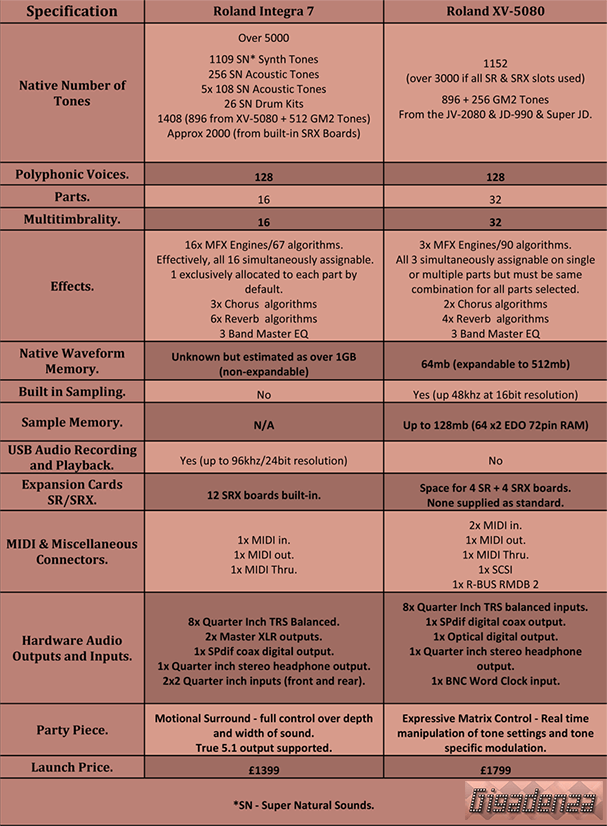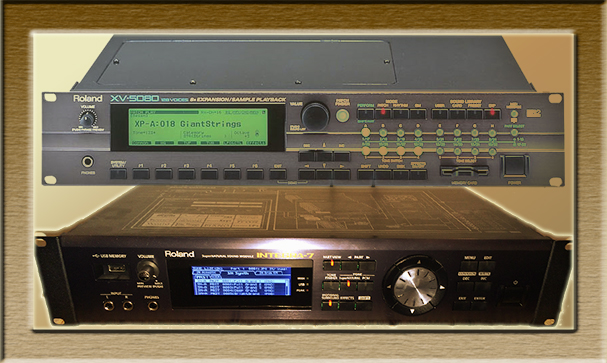Roland Integra 7
A match-up pulsating with potential, and why I refrained from disclosing the Inegra’s key attractions. Though frequently cited as the Fantom XRs intended heir, to me it seems that with hindsight, Roland judged the latter’s physical and technical merits sufficiently divergent from those featured in its XV brotherhood to induce a second, more profitable chance of honouring their momentous retirement and official relegation to a status of fusty, dusty legacy.
Were they anxious to try again? Did subsequent market research suggest a sizeable contingent of customers had peevishly passed up the Fantom, but might well make the jump were the traits of their cherished 5080 more thoroughly reproduced?
We don’t know. Nevertheless, save for a lack of on-board sampling, the Integra all but begs to be hailed as a homage to fleet XVs mother ship, endowed with every one of her native tones and a near identical array of audio outputs.

So what of the discrepancies? The XV, twice the parts, profoundly desirable. The Integra, a pair of XLR outputs – XLRs define professionalism and ooze appeal, even if you never use them! The XV, a qualified sampler with optical digital input and word clock inputs. The Integra, a high quality audio recording and playback interface with two pairs of stereo inputs.
The XV, three magnums of mulled MFX magic with 90 dynamic flavours, mixable on any or all of its parts in the portions you decree. The Integra, sixteen bottles of the same FX vintage harbouring 67 bedazzling bouquets, no infusions but every part individually served to order with a rare and exotic blend of incremental strength. Sorry, just a slight resurgence of smilies, won’t happen again.
The XV, two MIDI inputs to the Integra’s one, plus SCSI and R-BUS connectors, obsolete to the majority but always worthy of reference. So far, it seems the XV has edged ahead. A MIDI maestro with more than a grand to fritter would likely favour timbrel tissue over inherent audio capture and entrust a dedicated, “gold standard” solution to manage an intensive A/D D/A workflow.
But while no singular asset, however outstanding, should secure a synthesiser unanimous adulation, those fundamental and common to all take a logical precedence over transient gimmicks, and one of indisputable attraction and significance, is the repertoire, richness and resonance of tones.
We’ve already gathered the Integra comes laced with “Ye Olde 5080’s” luxurious library of loops. Out of respect, do we declare stalemate? Not quite. What of expandability? Glance one more at that lavishly lucid table.
The XV, space for eight sonorous side orders. Four slices of soft, succulent SR sponge of the traditional Victorian variety and four further, thicker slabs of creamy SRX crumble, with a fiendishly fruity and festive charm. However, yet again both cupboards were bare. Where those crochety, quavery treats should loiter, there was merely space.
How I weep as I wish for more wondrous wavs upon which my ears can gorge. Wait! I chose the Integra, not the 5080. Go on, one final time, the table of truth. Look! Not just the XVs assonance and dissonance and full oratorical virtuosity, but almost four thousand more samples besides. Room for eight expansion boards at over £150 a pop? I hardly think so. How about all twelve cards in the classic series, supplied as standard, to complement your scrumptious synergy of “Super Natrual” Synth and Acoustic” spices. Take it, the entire tray-bake of tonal delight.

Like every other Synth under scrutiny, each of the Integra’s parts could encompass one tone and ascribe it parameters pertaining to colour, texture, shape and dimension. Though only 16 parts strong, the range and depth of customisable elements this ravishing rompler affords each, is beyond rational reproach. For instance, Sc-8850 sports a 3 band master EQ, which after dialling in the desired values, can either be present or absent on the parts you pick. The Mu-2000 goes further. A 5 band master EQ common to all channels and constantly active, plus a 2 band EQ assignable to specific parts in uniquely adjustable amounts.
The Integra gives the boat one final shove with a triple band Master EQ, implementable on separate and collective parts. A second, dedicated three band EQ for each part with independent granularity and a sextet of 3 band EQs exclusive to the drum channel with an accompanying compressor. Enter the frequencies, attack and release times, gain and ratios you wish for all six, then send them either to channel itself or to any combination of the eight quarter inch outputs as a mono or stereo signal.
Not enough control? Here’s the coda. Communal reverb and chorus algorithms could attend to any pair of jacks in stereo and as individual entities whilst all 16 parts with their allotted patches and delicately crafted collages of chorus, reverb, pan, volume, velocity, pitch, key and vibrato could permeate an unconditional choice of outputs.
Please don’t flatter to deceive. When was the last time you mentioned the 5080? Oh yes, conveniently, just prior to fawning over the Integra’s excellence of EQ and vastly versatile routing virtues. You’ve danced away from the core issues and introduced two older synths, conveniently inferior in this respect but better equipped in others – when it comes to jack generosity and EQ agility, the 5080 barely trails, indeed, it might even steal the upper stave.
You’ve glossed over the “Party Pieces”, I’ll bet your imperturbable Integra has nothing like Expressive Matrix Control….HALT, and I’ll wager your extraordinary XV exhibits no equivalent to Motional Surround! I’ve availed neither nor covet to do so, thus, how about we canter to our table’s closing entry, perhaps more significant than any and unearth my most persuasive argument.
As much as you can exalt the XVs, fawn over the Fantom or juice up a JD. If we’re talking pound for pound, launch dates aside, all else being equal, the XV’s exclusion of any top up cards proves conclusive. The Integra, bearing a dozen deluxe bundles of delicious beats and sumptuous scales, is a veritable confectionery of voices that arrived on the high street for £400 less.




